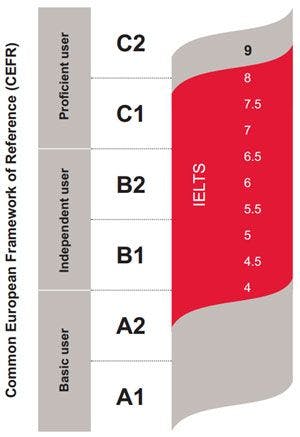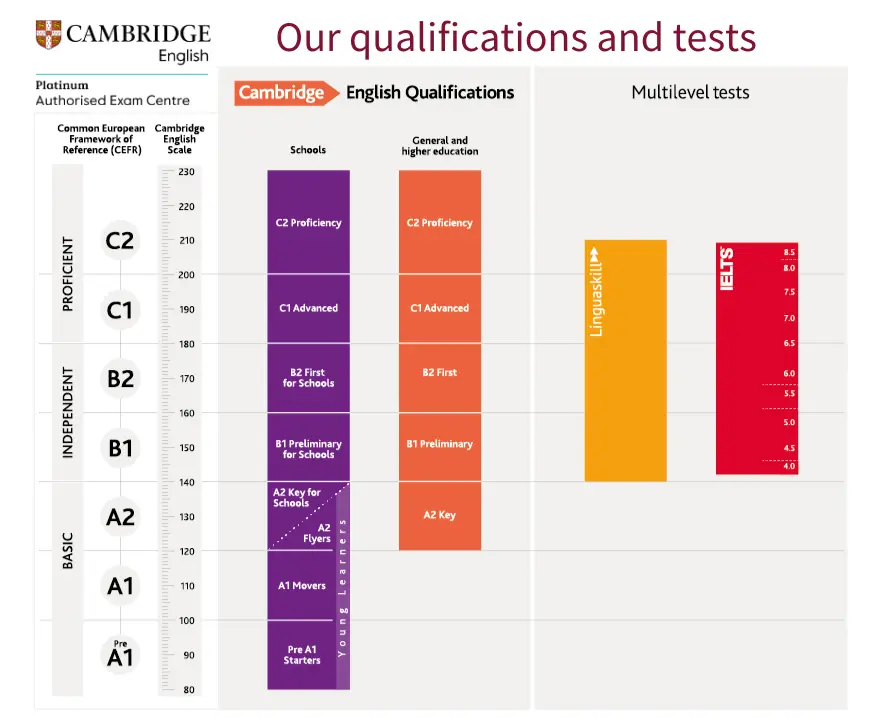IELTS results & certificates
IELTS results & certificates
IELTS results are delivered quickly and securely. By taking IELTS on computer, you will receive your results within just 3–5 days after your test. Learn how to check your IELTS results, understand your IELTS band score, and see how your results compare to the CEFR or Cambridge English Exams.
Have you registered for your IELTS test yet?
Check all available dates! We offer numerous exam dates for all levels, every month, across Switzerland.
IELTS results in Switzerland
IELTS results in Switzerland are available 3–5 days after your test. You can view your scores and download your electronic Test Report Form (eTRF) through the official British Council Test Taker Portal. IELTS on computer and IELTS Online results are provided only electronically (results are not issued as additional paper Test Report Forms) and are not given by phone or email.
How long does it take to get IELTS results
IELTS on Computer
Your results are available 3–5 days after your test date. You will receive access to your electronic Test Report Form (eTRF) through the British Council Test Taker Portal.
IELTS Online
Results are released 6-8 days after your test. You can download your eTRF directly from the British Council Test Taker Portal.
How to check your IELTS results online
Once your results are released, you will receive an email notification with a link to view your scores online through the British Council Test Taker Portal. You can download and print your electronic Test Report Form (eTRF) to share with the organisations you are applying to. You may also email your eTRF directly to institutions. Alternatively, you can send your results directly through the British Council Test Taker Portal.
How to understand the IELTS band score
You will be awarded an IELTS band score from 0-9 for each test section, which reflects your proficiency in English.
Your IELTS Test Report Form will show a score for each of the four skills (Listening, Reading, Writing and Speaking) and an overall band score. You can receive whole band scores (5.0, 6.0, 7.0) or half band scores (5.5, 6.5, 7.5) in every section of the test.
| IELTS Band Score | Skill Level | Description |
|---|---|---|
| Band Score 9 | Expert user | The test taker has fully operational command of the language. Their use of English is appropriate, accurate and fluent, and shows complete understanding. |
| Band Score 8 | Very good user | The test taker has fully operational command of the language with only occasional unsystematic inaccuracies and inappropriate usage. They may misunderstand some things in unfamiliar situations. They handle complex and detailed argumentation well. |
| Band Score 7 | Good user | The test taker has operational command of the language, though with occasional inaccuracies, inappropriate usage and misunderstandings in some situations. They generally handle complex language well and understand detailed reasoning. |
| Band Score 6 | Competent user | The test taker has an effective command of the language despite some inaccuracies, inappropriate usage and misunderstandings. They can use and understand fairly complex language, particularly in familiar situations. |
| Band Score 5 | Modest user | The test taker has a partial command of the language and copes with overall meaning in most situations, although they are likely to make many mistakes. They should be able to handle basic communication in their own field. |
| Band Score 4 | Limited user | The test taker's basic competence is limited to familiar situations. They frequently show problems in understanding and expression. They are not able to use complex language. |
| Band Score 3 | Extremely limited user | The test taker conveys and understands only general meaning in very familiar situations. There are frequent breakdowns in communication. |
| Band Score 2 | Intermittent user | The test taker has great difficulty understanding spoken and written English. |
| Band Score 1 | Non-user | The test taker has no ability to use the language except a few isolated words. |
| Band Score 0 | Did not attempt the test | The test taker did not answer the questions. |
IELTS section band scores
Each part of the IELTS test receives an individual band score from 0–9, which reflects your English proficiency in that specific skill. These four scores are then averaged to calculate your overall IELTS band score. Below is an overview of how each section is assessed:
IELTS Listening band score
Your IELTS Listening score is based on the number of correct answers out of 40 questions. Each correct response earns 1 point. Your total points are then converted to the IELTS 9-band scale, which is reported using whole and half band scores.
IELTS Reading band score
IELTS Reading is also scored out of 40 questions, and each correct response earns 1 point. Your total points are then converted to the IELTS 9-band scale, which is reported using whole and half band scores.
IELTS Writing band score
IELTS Writing is assessed by examiners using four criteria:
- Task achievement for writing task 1 and task response for writing task 2
- Coherence and cohesion
- Lexical resource
- Grammatical range and accuracy
IELTS Speaking band score
IELTS Speaking is assessed by examiners using four criteria:
- Fluency and coherence
- Lexical resource
- Grammatical range and accuracy
- Pronunciation
IELTS and CEFR: How IELTS band score compares to the CEFR

The CEFR is an international standard for describing language ability. It marks an individual's language skills along a six-mark scale ranging from A1 (beginners) to C2 (advanced).
IELTS band scores range from 0 - 9. IELTS teachers can map scores against the Common European Framework to help gauge a candidate's language ability.
IELTS vs Cambridge English Exams: Score comparison
In this overview, you can see how the IELTS scores and Cambridge English Exams scores are compared on the CEFR (Common European Framework of Reference) and Cambridge English Scale.

How to add your IELTS score to LinkedIn
Showcase your English proficiency and strengthen your career prospects by adding your IELTS Test Report Form (TRF) to your LinkedIn profile. This helps future employers quickly understand your language skills and enhances the attractiveness of your profile.
Follow these simple steps to add your IELTS certification to LinkedIn
-
Name of certificate: add the name of your qualification and your score. Example: IELTS - Band Score 8.0
-
Issuing organisation: add Swiss Exams - Authorised Provider for Cambridge English Exams.
-
Expiry: Add the expiration date.
-
Issue date: Add the month and year you took the exam.
-
Test Report Form ID: in order for companies to verify your result you can add your TRF ID Number. You can find your ID Number on your Test Report Form (TRF).
-
Credential URL: add the official website associated with your qualification.
IELTS results FAQs
Assistance for candidates
We are here for you. Here’s how to reach us in no time: Select your request, enter your exam details and submit your query.
Assistance for schools and teachers
Our staff is happy to help and advise you competently. We look forward to your call or email.
